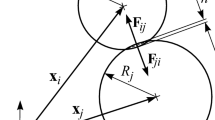Abstract
The traditional Hertz contact theory has been widely used in solving contact problems. However, it is only applicable to the elastic contact, and cannot truly reflect the contact stress distribution and contact radius in the elasto-plastic contact. In this work, based on the Hertz contact theory, a fast solving method is proposed to calculate the contact stress distribution and contact radius in the elasto-plastic contact between two spheres. It is assumed that the elastic contact only occurs at the outer edge of contact patch and its contact stress distribution satisfies the Hertz contact theory, and the contact stress distribution at the inner edge of contact patch can be superimposed by a constant contact stress and several small ellipsoidal contact stress distributions. Moreover, based on the equivalent relation between the resultant force of contact stress and the normal external load, the contact radius in the elasto-plastic contact can be solved. Finally, an elasto-plastic contact example of two spheres is given based on the power-law hardening material model, and the influences of material parameters, contact radii and normal external loads on the accuracy of the proposed method are discussed by comparing the differences between the numerical results by finite element method and the predicted ones by the proposed method. It is shown that the proposed method can accurately calculate the maximum contact stress and contact radius in the elasto-plastic contact, and the relative errors of both maximum contact stress and contact radius are within \(\pm \,5{\%}\). To sum up, the proposed fast solving method can be applied to perform the elasto-plastic contact analysis in engineering practice.























Similar content being viewed by others
References
Guan CP, Jin HP. Calculation analysis for elastic-plastic contact between ball and plane. Bearing. 2014;8:5–8 (in Chinese).
Li ST. A mathematical model and numeric method for contact analysis of rolling bearings. Mech Mach Theory. 2018;119:61–73.
Shen GX, Shu XD, Li M. The 3-D boundary element method of roller bearing by plate element analogue. Acta Mechanica Solida Sinica. 2001;14(3):268–74.
Zhang J, Sun S, Jin XS. Numerical simulation of two-point contact between wheel and rail. Acta Mechanica Solida Sinica. 2009;22(4):352–9.
Jin XS, Liu QY. Tribology of wheel and rail. Beijing: China Railway Press; 2004. p. 1–6 (in Chinese).
Shen ZY, Zhang WH, Jin XS, et al. Advances in wheel/rail contact mechanics. China Railw Sci. 2001;2:4–17 (in Chinese).
Medvedev VI, Volkov AE, Volosova MA, et al. Mathematical model and algorithm for contact stress analysis of gears with multi-pair contact. Mech Mach Theory. 2015;86:156–71.
Johnson KL. Contact mechanics. Cambridge: Cambridge University Press; 1985. p. 153–96.
Cao SH, Li X, Zhang SF, et al. Research of the differences between Hertz theory and finite element method to analyze the fatigue of wheel/rail contact. J Mech Eng. 2015;51(6):126–34 (in Chinese).
Yan WY, Fischer FD. Applicability of the Hertz contact theory to rail-wheel contact problems. Arch Appl Mech. 2000;70(4):255–68.
Yan WY, Bus so EP, O’Dowd NP. A micromechanics investigation of sliding wear in coated components. Proc R Soc A Math Phys Eng Sci. 2000;456(2002):2387–407.
Hardy C, Baronet CN, Tordion GV. The elasto-plastic indentation of a half-space by a rigid sphere. Int J Numer Methods Eng. 1971;3(4):451–62.
Thornton C, Ning Z. A theoretical model for the stick/bounce behaviour of adhesive, elastic-plastic spheres. Powder Technol. 1998;99(2):154–62.
Thornton C, Cummins SJ, Cleary PW. On elastic-plastic normal contact force models, with and without adhesion. Powder Technol. 2017;315:339–46.
Brake MRW. An analytical elastic-plastic contact model with strain hardening and frictional effects for normal and oblique impacts. Int J Solids Struct. 2015;62:104–23.
Brizmer V, Kligerman Y, Etsion I. The effect of contact conditions and material properties on the elasticity terminus of a spherical contact. Int J Solids Struct. 2006;43(18–19):5736–49.
Sebès M, Chollet H, Ayasse JB, et al. A multi-Hertzian contact model considering plasticity. Wear. 2014;314(1–2):118–24.
Zhu HB, Zhao YT, He ZF, et al. An elastic-plastic contact model for line contact structures. Sci China Phys Mech Astron. 2018;61(5):054611.
Zhu HB, He ZF, Zhao YT, et al. Experimental verification of yield strength of polymeric line contact structures. Polym Test. 2017;63:118–25.
Su HY, Lv D, Li Y, et al. The discussion on the formula of strain hardening exponent (\(n\)-values). Ptca Part A Phys Test. 2006;12:621–3 in Chinese .
Yu WP, Blanchard JP. An elastic-plastic indentation model and its solutions. J Mater Res. 1996;11(9):2358–67.
Wu CY, Li LY, Thornton C. Rebound behaviour of spheres for plastic impacts. Int J Impact Eng. 2003;28(9):929–46.
Acknowledgements
Financial supports by the Joint Fund for Basic Research of High-Speed Railways (U1734207), National Key Research and Development Plan (2017YFB0304500), National Natural Science Foundation of China (11572265), the Projects of Sichuan Province (Nos. 2017JQ0019, 2017HH0038), and the Projects of Traction Power State Key Laboratory (Nos. TPL1606, 2017TPL_T04) are acknowledged.
Author information
Authors and Affiliations
Corresponding author
Rights and permissions
About this article
Cite this article
Zhao, J., Kan, Q., Fu, P. et al. An Elasto-plastic Contact Solving Method for Two Spheres. Acta Mech. Solida Sin. 33, 612–634 (2020). https://doi.org/10.1007/s10338-020-00164-1
Received:
Accepted:
Published:
Issue Date:
DOI: https://doi.org/10.1007/s10338-020-00164-1




